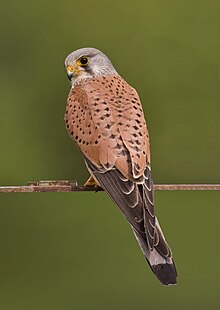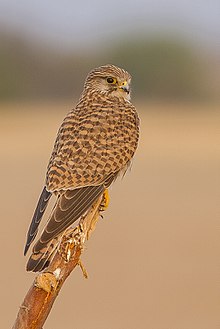Common Kestrel
| Common kestrel | |
|---|---|
 |
|
| Adult male Falco tinnunculus tinnunculus | |
 |
|
| Female(♀) Falco tinnunculus tinnunculus from Tal Chhapar Sanctuary, Churu, Rajasthan, India | |
| Scientific classification | |
| Kingdom: | Animalia |
| Phylum: | Chordata |
| Class: | Aves |
| Subclass: | Neornithes |
| Infraclass: | Neognathae |
| Superorder: | Neoaves |
| Order: | Falconiformes |
| Family: | Falconidae |
| Genus: | Falco |
| Species: | F. tinnunculus |
| Binomial name | |
|
Falco tinnunculus Linnaeus, 1758 |
|
| Subspecies | |
|
About 10, see text |
|
 |
|
| Global range of F. t. tinnunculus Year-Round Range Summer Range Winter Range | |
| Synonyms | |
|
Falco rupicolus Daudin, 1800 (but see text) |
|
About 10, see text
Falco rupicolus Daudin, 1800 (but see text)
Falco tinnunculus interstictus (lapsus)
The common kestrel (Falco tinnunculus) is a bird of prey species belonging to the kestrel group of the falcon family Falconidae. It is also known as the European kestrel, Eurasian kestrel, or Old World kestrel. In Britain, where no other kestrel species occurs, it is generally just called "the kestrel".
This species occurs over a large range. It is widespread in Europe, Asia, and Africa, as well as occasionally reaching the east coast of North America. But although it has colonized a few oceanic islands, vagrant individuals are generally rare; in the whole of Micronesia for example, the species was only recorded twice each on Guam and Saipan in the Marianas.
Common kestrels measure 32–39 cm (13–15 in) from head to tail, with a wingspan of 65–82 cm (26–32 in). Females are noticeably larger, with the adult male weighing 136–252 g (4.8–8.9 oz), around 155 g (5.5 oz) on average; the adult female weighs 154–314 g (5.4–11.1 oz), around 184 g (6.5 oz) on average. They are thus small compared with other birds of prey, but larger than most songbirds. Like the other Falco species, they have long wings as well as a distinctive long tail.
Their plumage is mainly light chestnut brown with blackish spots on the upperside and buff with narrow blackish streaks on the underside; the remiges are also blackish. Unlike most raptors, they display sexual colour dimorphism with the male having fewer black spots and streaks, as well as a blue-grey cap and tail. The tail is brown with black bars in females, and has a black tip with a narrow white rim in both sexes. All common kestrels have a prominent black malar stripe like their closest relatives.
...
Wikipedia

